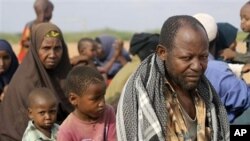As the rainy season in Kenya continues, resources at the Dadaab refugee camps are being stretched to the limit. With refugees pouring across the Somali border, the demands of local politicians are forcing the humanitarian agencies to simply turn families away.
In Northeastern Kenya, the ever-expanding Dadaab refugee camp may finally have reached its limit. Over the past four months, overcrowding at the camps have forced United Nations officials to settle newcomers outside the camps, often without proper access to food, sanitation and shelter.
The U.N. Refugee Agency, UNHCR, estimates that as many as 9,000 people who have arrived since July are living in unsuitable conditions.
According to Doctors Without Borders' (Médecins Sans Frontières) Kenya chief Joke Van Peteghem, the influx of seasonal rains have only exacerbated the situation Dadaab's new arrivals.
"They do not have any shelter. They do not have any sanitation. No water supply. And the problem is that since last week, the rains have started - and the lands where they are camping is lowlands - so the whole area is flooded. People have lost the little food they have - it is completely spoiled. They are using the rainwater now for drinking water and as a result of that we are starting to see an increase in diarrheal cases," explained Van Peteghem.
Dadaab is the world's largest refugee settlement, formed by the Dagahaley, Hagadera and Ifo camps. Established in the early 1990s to receive refugees fleeing warlord violence, the camps were initially planned for around 90,000 residents.
But the violence in Somalia never stopped, and the camps kept growing. Dadaab's population began to explode around 2007, when the al-Qaida linked insurgency in Somalia sent hundreds of thousands across the Kenyan border.
Now over 300,000 refugees call Dadaab home and humanitarian agencies can't keep up.
What Dadaab drastically needs is more space. Some new residents have been able to squeeze in with friends and family; but there is simply no physical space for others.
While UNHCR has continued to register and provide food for incoming refugees, they cannot provide them with shelter or protection.
UNHCR has been in negotiations with local community representatives such as Parliament Deputy Speaker Farah Maalim and MP Ahmed Sugow - who represent the Dadaab area - to expand the camps. But UNHCR representative Emmanuel Nyabera said certain demands have made progress difficult.
"The resistance has a lot of demands: That before we set up a camp, we have to give assurance of environmental impact of the camp, which we've done. There has also been the issue of employment. There have been demands that the majority of the people we employ should come from the local community," said Nyabera.
Neither Sugow nor Maalim were available for comment. According to Nyabera the latter demand is difficult because much of the camp staff must be experts in the fields of medicine, public health and logistics.
After nearly two years of negotiations, the government and local community have granted UNHCR land to expand the Ifo camp, into new sites called Ifo Two and Three. But these new facilities, designed to hold around 80,000, have mainly been allocated to existing residents of Dagahaley and Ifo.
Many of the planned parts of the camp have become run-down as more residents arrive and the influx has been damaging to the local environment. The new Ifo sites are intended to alleviate pressure on logistics and the environment, not to accommodate new residents.
And despite the new land, Nyabera told VOA the actual relocation of camp residents to the new sites requires the final approval of local officials, which has not been granted.
"We even took some of the local leaders to walk Dagahaley, to where they saw the states in which some of the refugees are living. And then we took them to Ifo to see how planned Ifo is. But still we are yet to get authorization for us to relocate," he said.
While the Kenyan government has accepted hundreds of thousands of refugees over the past decades, it has recently come under fire for its treatment of refugees in Dadaab. In 2009 Human Rights Watch released a report detailing local backlash to the refugee influx as well as abuse and mistreatment of refugees crossing the border by Kenyan police.
Local Resistance Leaving Somali Refugees Without Shelter in Kenya





